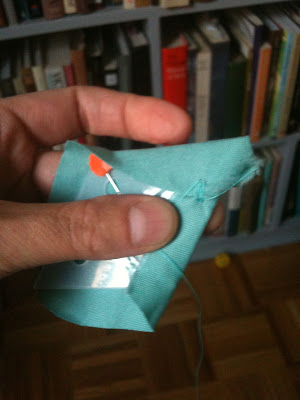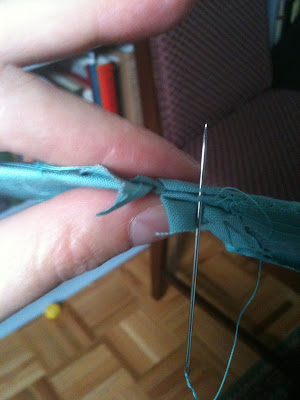This week I have been having fun churning out some large hexagons for the Hexalong (hexagon quilt-along) being hosted by Lynne of Lily's Quilts and Gayle Brindley. As I described in an earlier post, I decided to make my hexagons quite large -- 4" along each side. I ordered some supplies at the beginning of the week, including a variety of precut hexies and 4" 60 degree diamonds from Paper Pieces and also some plastic "Quilt Patis" from Sew Sisters -- which is a great little quilt shop in North Toronto. Sew Sisters is having a Free Shipping sale this week -- yay! -- and my Quilt Patis arrived within a couple of days. Hip hip hooray!
Quilt Patis are plastic templates used for EPP (English Paper Piecing). In the past two days I have come to love them because they allow for very crisp shapes and points and they're endlessly reusable.
They also allow for piecing without sewing any basting stitches.
If you're completely new to paper piecing it might be worth clarifying: when you work with large shapes cut from paper, you generally wrap your seam allowances around the paper shape, and baste (temporarily stitch) your fabric right through the paper.
ETA: Precut shapes like those from Paper Pieces are reusable, even after you remove your basting stitches! Homemade paper shapes seem to show their wear much more...or at least mine do :(
Here's an example: my first of the large hexies, stitched to a homemade printer-paper template.
As you can see, the basting stitches are large and need to be highly visible (they're taupe; squint and you'll see them!) -- because they will need to be removed later, when the quilt top is assembled and they're no longer needed.
Lynne posted an excellent tutorial on EPP here, and I know there must be many more available.
While this traditional method works well, I have to say that all that cutting of paper pieces and stitching things that later need to be removed can test my patience. So for many of my hexies I am going to be doing what I did intuitively when I first played with EPP: sewing shapes without basting.
The no-basting approach won't be reliable for larger sizes of paper pieces, but it certainly worked very well for me when making smaller ones, like the 1" hexagons I was playing with last spring
and it is the method you use with plastic Quilt Patis too.
DISCLAIMER: These steps are super-quick and easy, and when I first started making hexagons I had no idea that I was leaving out a step. When I discovered that other people basted their hexagons, I worried that there might be some terrible unforeseen consequence to my improvised method. But there isn't...and I recently discovered that I'm not the only one doing things this way. Phew.
Anyway, you might find that you like making no-baste hexagons so much that you'll need to buy yourself a jumbo bag of precut paper pieces, like I did!
Here's what I do: I either pin the hexie to my fabric, or just hold it firmly if no pin is at hand.
Then I cut around the paper piece, leaving at least 1/4" all around. I don't generally work with white fabrics, so I don't have to stress about the neatness or precision of my cutting: it won't be seen.
Now you just fold and wrap...kind of like wrapping a present.
With needle and thread (of any colour -- it won't be seen), catch the fabric to the left and right of the fold, but don't penetrate the paper piece inside.
I don't bother to knot the thread -- it will never need to be removed, but it also isn't essential to the stability of a finished quilt top. It's only purpose is to give the hexie shape during piecing. I have found that three nice tight stitches hold firmly, without a knot. I hope that works for you too!
Continue to fold and stitch about three times in every corner, just carrying the thread as you move around the perimeter of the shape.
Voila!
Go on and make hundreds of these little cuties...you know you want to!
****
It was very easy for me to get started using Quilt Patis, because they are actually designed to be used the same way I was using my paper pieces: without basting stitches.
Here's how I used 2" diamonds to make these 4" star hexies:
Once again, I cut around the shape, leaving a reasonable seam allowance but not worrying much about accuracy.
Fold and pinch firmly
and then fold a corner at one of the points of the diamond. Here accuracy does matter, and these corners are much sharper than those of a hexagon: take care to fold a nice crisp point. You will have a little flap of extra fabric folded over to one side.
Insert the needle, catching the fabric on either side, a comfortable distance from the point.
I make three nice, tight, secure stitches.
I move around the perimeter, aiming to make crisp corners as I go, taking a few firm stitches at each point.
When all four corners are done, I can stop and admire my work. The points of the diamond look crisp, and the folded bits of corner fabric are visible, even from the front - but that's fine.
It takes six of these diamonds to make a star. The plastic Patis help to keep the shapes very well-defined, so you can match up sides perfectly and whipstitch them together.
Take a look at Lynne's excellent whipstitch video -- this stitch is easy and also essential to assembling your EPP shapes -- whether you're connecting little hexies or triangles-within-a-hexagon. Here's some stitching where you do most definitely want to knot your thread! This is sewing-for-construction: these are stitches that need to hold for a good long time, so make them as secure as possible -- without pulling too tightly.
Matching the beginnings and endings of the diamonds' sides is key here. I hold quite firmly as I whipstitch. It's fun to see the star shape emerge as you add diamonds.
I haven't found any problem working around the little flappy bits that result from each folded corner. I just nudge the flaps aside so I can keep working the whipstitch neatly through the inside edges of each diamond side. I try to pay special attention to lining up the inside corners, where all six diamond points are going to meet.
Penelope is a great help.
Not.
and soon you have a finished hexie star! And no basting stitches to remove...ever!
I make no claim at originality here, but I really hope that this little tutorial is helpful to you. Sorry to ramble on...I'll leave you to your sewing!





































19 comments:
Great tutorial. I had never heard of patis before, I wonder where that word comes from. Thanks for taking the time to do this!
I've been doing hexagons this way for years. One tip for you, use a hole punch to punch a hole in the shape, hex, diamond, etc. You can pin thru this hole, but more importantly, using a skewer, you can easily pop the shape out when you've got it surrounded by other shapes.
And I'm blaming you for the fact that I also joined this project! I REALLY, REALLY did NOT need to start another project....
Thank you so much for the feedback, Gayle and Liz -- and for adding that great tip, Liz! I think there may be a flurry of punched-hole-paper-bits in my future....And I'm glad to hear that there's some HAL-ing in yours!
As for the root of the name "Quilt Patis": I was imagining all sorts of exotic sources (was it French? Spanish? An acronym of some kind?), but I think it is actually the inventor's first name rendered plural :)
Thanks very much for this tute! I'm definitely going to try leaving the 'flappy' bit at the corners. Your diamonds look very polished - no pun intended!
This would make a great guest post if you would be interested - just drop me a line at lilysquilts @ gmail . com and we can organise it. It's a fun way to re-direct some extra traffic to your blog too :-)
Thanks for the tutorial! I am going to try this basting method for my next set of diamonds (with hole in the paper too ;-)) and see about trying to get some of these Quilt Patis in the UK.
I've never made hexies before and your tutorial is brilliant.....really simple and easy to understand. I'm having a go at all the different tutorials for the Hex-A-Long.....and having a ball!
Oops! I forgot to say....THANK YOU and the time you have put into making the tutorial is very much appreciated.
lovely tute ... I'm itching to do some diamonds ... no no no ... yes yes yes
Thank you soooo much for the comments, everyone! It's great to know that this tutorial might be useful or inspiring, and I love hearing additional tips too :)
Thanks for the tute. I'd never heard of Patis and when you and a couple of others mentioned this on flickr the othe day I had no idea what it was! Being plastic are they hard to remove and sew with when you've joined lots? I once made the mistake of using cardboard ceral boxes to make some hexie templates. After I'd joined a few together the whole thing was too inflexible to work with! lol
Interesting tute, thanks.
Thanks for the feedback, IJ and Sheila; much appreciated!
As for removing the plastic Quilt Patis: each of these diamonds has 4 holes in it, so they look to be very easy to remove after piecing. They're not completely rigid (they're actually pretty flexible, so there's enough give to each one to sew a "V". With star hexagons like the ones I have been making, the 6 inner Patis can be removed once the hexagon is complete (only the outer 6 are needed to keep the hexie's shape until it has been whipstitched to all its neighbours!) -- so that keeps things a little more flexible too :)
I've never heard of Quilt Patis either, but just might have to try them. I also love doing no-baste hexies, but I do mine different, with Best Press, so you don't have to make any stitches until you sew them together...
I'm also doing Lynne's Hexalong so the quilt patis would be v.handy indeed as I would like to mix diamonds with hexies. Jxo
I'm also a follower. Jxo
Thanks for this tutorial - I haven't made hexies yet but want to try them soon.
Thanks for the clear tutorial. I have a question.
I am wondering about those flaps when finished with the block?(from 2" diamonds to make these 4" star hexies)
Are they just ignored &/or do they cause any lumps when putting several together making a quilt top?
Thanks for your help
I do the same thing with the purchased paper pieces except I don't cut around the hexagon I just use 2.5" squares of fabric. Moda now has the mini charms which are that size or you can cut charm picks in quarters and have that size. They fit the 1" hexagon paper pieces. Great tutorial!
Post a Comment